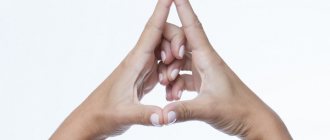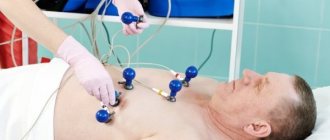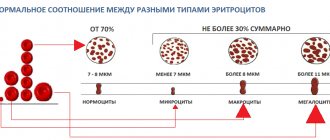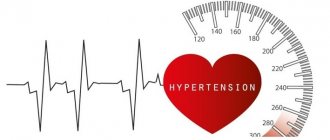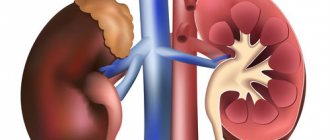Yoga is a combination of spiritual and physical practices that are designed to relax and create harmony in the physical and psychological state.
Yoga exercises for illnesses help normalize the activity of internal organs, calm the nervous system, and also normalize blood pressure monitor readings. It is necessary to choose the right asanas, since some yoga techniques can increase blood pressure, and some can lower it.
Causes
High blood pressure occurs due to narrowing of the lumen of blood vessels, which forces the heart to work harder.
Hypertension can occur for the following reasons:
- overweight;
- poor nutrition;
- too intense or sudden physical activity;
- metabolic disorder;
- hormonal changes;
- smoking, drinking alcohol;
- disruption of the kidneys, liver, damage to the small intestine.
In addition, one of the main causes of hypertension is stress, during which a lot of adrenaline is produced.
Reference! Yoga helps with back problems and hemorrhoids, as well as headaches.
Causes of low blood pressure or hypotension may include:
- stress;
- hormonal disorders;
- sedentary lifestyle.
Ayurveda recommendations
According to Ayurveda, hypertension is a consequence of a clogged digestive tract, clogged arterial vessels and regular stress.
It is important to follow a diet that is based on healthy eating. To preserve the beneficial properties of products, they do not need to be heated. It is recommended to avoid foods such as: wheat, rye, barley, oats, potatoes, peanuts, meat, eggs, cheese, butter, bananas, figs and all fatty, fried foods.
IMPORTANT! You need to give up alcohol and smoking!
You should include in your diet: orange, watermelon, apple, plum, amaranth, spinach, cabbage, cucumber, carrots, beets, ginger.
Recipes
Ayurveda has several recipes for lowering blood pressure:
- Mix a teaspoon of onion juice and honey in a 1:1 ratio. Take for 15-20 days on an empty stomach.
- Dilute a cup of milk in three cups of water and cook in it 20 grains (0.0648 grams) of garlic and grapes. Take 15 days or a month in the morning and evening, dividing the dose in half.
- Mix orange juice and coconut water in a 2:1 ratio. Take 0.5 cups three times a day.
- In the morning, it is useful to drink a cup of water, to which you need to add a teaspoon of honey and 5 drops of apple cider vinegar.
Exercises to reduce high blood pressure
Paschimottanasana
Starting position – sitting on the floor. Legs are straight, palms should touch the floor. You need to exhale, stretch your arms forward and touch your toes. The knees should remain straight. It is necessary to stay in this position for 1-3 minutes, and then return to the starting position.
This exercise to reduce blood pressure irritates the vagus nerve and thus calms the nervous system.
Prasarita Padottanasana
Starting position – standing. The legs are spread wide, the stomach is pulled in, the back is straight, the palms are on the waist, the shoulder and elbow joints are raised.
Next, while inhaling, you need to tilt and lower your arms bent at the elbows to the floor so that your palms and feet form one line. Knees should be straight. You need to stay in this position for 2-30 seconds, and then return to the starting position.
Utthita Trikonasana
Your legs should be spread 1 meter apart (if possible), your arms should be extended to the sides so that your palms face down.
The feet must be turned to the right side: the left one by 45 degrees, and the right one by 90. As you inhale, bend over and place your right hand on the floor parallel to your right foot. The left hand should be raised up and continue the line of the right hand. The neck is extended, the gaze is directed to the left hand.
Hold the pose for 20-30 seconds, then repeat the exercise on the other side.
In this asana, the arms and legs should move as intensely as possible. IMPORTANT! Yoga exercises for high blood pressure will give results only with regular practice.
In addition, it is important to lead a healthy lifestyle: eat right and quit smoking and alcohol. It is necessary to perform exercises and increase the load gradually, constantly monitoring blood pressure.
Can hypertensive patients do yoga?
It has been proven that yoga not only improves well-being, but also reduces the symptoms of hypertension! Proper daily exercise helps reduce the dosage of blood pressure medications.
Arterial hypertension is not a reason to give up your usual workouts. Exercise therapy is a way to maintain your health and physical fitness. And if you have never exercised before being diagnosed with high blood pressure, then the time to start doing it is now.
For hypertensive patients, it is necessary to learn how to cope with stress. Both regular exercise and other useful practices help increase stress resistance. These are relaxation and auto-training sessions, yoga classes.
Consultation with your doctor and yoga therapist is necessary before starting classes.
These specialists evaluate your overall health and severity of illness. Taking this data into account, goals are set and an individual training program is drawn up.
To increase with hypotension
By regularly practicing asanas, hypotensive patients can restore vascular tone, and with it vigor and activity.
Adho Mukha Svanasana
You need to get on all fours, place your arms and legs shoulder-width apart so that your hips and arms are perpendicular to the floor.
Next, you need to push strongly off the floor with your palms and move your buttocks back and up, while touching the support with the upper part of your forehead.
Your knees should be straight, your heels pressed to the floor, and your breathing should be even and calm. You need to perform the exercise for 1-3 minutes. REFERENCE! To ensure that the pressure of the forehead on the support is not excessive, it is necessary to push strongly off the floor with your hands.
Halasana
Starting position – lying on your back. The legs should be straight, the toes are slightly tilted forward, the arms are spread to the sides, and then pulled back behind the head.
As you exhale, you need to raise your knees to your chest, while making sure that your pelvis does not lift off the floor. Next, helping with your hands, you need to throw your legs over your head, your socks should touch the floor. Then move your arms behind your back, supporting the pose with your palms. Legs should be extended.
This pose must be held for 3-5 minutes and then returned to the starting position. With this exercise you can relax the vertebrae, relieve tension in the blood vessels and restore blood circulation.
Legendary meditation course without payment We recommend! The most popular meditation course for beginners in Russian. More than 100 thousand people have already learned to meditate. Try it yourself. Read more.
Parshvottanasana
Feet are shoulder-width apart, the right foot is 90 degrees to the right, and the left is 45 degrees. The arms are behind the back, the elbows are bent, the palms are folded. The resulting “lock” must be pulled upward to open the chest.
As you exhale, you need to bend, releasing your body towards your right leg so that your face is at knee level. You need to stay in this pose for 20-30 seconds, then repeat it for the other leg.
Pincha Mayurasana
This is one of the most effective poses for hypotensive patients, which needs to be mastered near a wall. You need to sit opposite the wall, place your forearms on the floor wider than your shoulders, parallel to each other. Next, you need to push off the floor with your right foot, lift your left leg by inertia and touch the wall with your heels.
Straighten your arms as much as possible, try to stretch your body up.
In this position, take 3-4 breaths, then slowly lower your right leg to the floor, then your left. ATTENTION! Each asana should be performed for 30-40 seconds. In all positions, the throat and neck should be relaxed and breathing should be free.
Factors contributing to hypertension
There are factors that influence the possibility of dilatation of arteries. They are related to our lifestyle. This includes poor nutrition, which leads to obesity and the development of atherosclerosis. The development of the disease leads to loss of elasticity and inability to expand the diameter of blood flow. When the heart speeds up and the arteries cannot expand, blood pressure rises. In addition, the walls of the arteries thicken, reducing the volume of blood circulation, which also contributes to hypertension.
Yoga for hypertension, and its special positions, help arteries become more elastic. They become more flexible, their ability to expand increases, and even if the heart beats faster, the pressure rises slowly. Many asanas are performed in such a way as to reduce the flow of blood to some area in a short time.
The subsequent "open" acts as the "open dam" effect. The blood flows faster and cleanses the arteries (Virasana asana, when the leg is bent, expansion occurs). Pressure surges are accompanied by a feeling of warmth. It can be reduced by performing relaxation positions. It is worth paying attention to Supt Baddha Konasana. Thanks to the specific position of the arms and legs, it is possible to quickly cool the body in those places where important lymph nodes are located.
Chronic stress is our enemy. The body responds to the mistaken impression that life is in danger by increasing blood pressure allowing it to keep us in a "defense or flight" state of readiness. This state persists even during sleep, so it is shallow and short. The practice of asanas allows you to relax the muscles along the spine, calm the nervous system, and reduce stress. Regular practice allows you to not react so violently to various life situations and, as a result, there are no sudden surges in pressure.
Preventive exercises to normalize blood pressure
The combination of these asanas triggers the body’s self-regulation and normalizes blood pressure. It is recommended to perform this complex three times a week.
- Five-pointed star . The back is straight, the legs are wider than the shoulders, the arms are spread out to the sides parallel to the floor. The back of the head stretches upward, and the arms and legs are as straight as possible. Next, you need to perform 6 breathing cycles: alternating a slow deep breath with a smooth exhalation.
- Semicircle . You need to kneel down and move your right leg to the side so that your foot touches the floor. The left palm should be placed on the floor and the right palm should be extended upward. You need to do it in turn for each side, holding the pose for about a minute.
- Puppy . You need to kneel and then sit so that your buttocks are higher than your feet. Next, you need to touch the floor with your hands and extend your palms as far as possible.
- Table . You need to focus on your knees and palms, and then stretch your right hand forward, your left foot back.
- Cat . Focus again on your knees and palms. As you inhale, you need to raise your head up and arch your back down as much as possible, and as you exhale, lower your head and round your back.
REFERENCE! It is advisable to perform yoga exercises in the first half of the day.
Child's Pose
fotolia
Important: not all asanas help lower blood pressure. Some, for example inverted ones, on the contrary, increase it. Therefore, it is important to avoid them. While doing the exercises, try to completely relax. Do asanas slowly and smoothly. Monitor your health: if it worsens, you should stop training immediately.
Breathing exercises
Yoga breathing exercises have a beneficial effect on the central nervous system and promote relaxation.
The most common breathing technique is Nadi Shodhana pranayama. It helps bring the internal state to balance, harmony and positivity. To perform it, you need to close your right nostril with your hand and take a slow, deep breath through the left. Then close your left nostril and exhale through your right. Do the opposite combination of breaths and repeat the cycle 5-8 times.
Breathing exercises together with active movements will promote more intense blood circulation and increase the overall tone of the body.
Yoga is also useful
With constant and slow yoga practice, your body will begin to react differently to external stimuli, resistance to stress and excessive loads will appear and there will be:
- expand the shoulder muscles;
- headache and dizziness go away;
- dilate blood vessels;
- improve mood;
- strengthen the chest, as well as veins and arteries;
- relax the muscles of the whole body;
- calm the nervous system;
- relieving stress and tension on the cervical spine.
In the fight against hypertension, you can (and should) perform the following asanas:
- Pastimottanasana.
- Baddha konasana.
- Savasana.
- Five-pointed star.
- Semicircle pose.
- Surya bhedana pranayama.
Contraindications
Inverted asanas that can increase blood pressure should not be performed:
- people with spinal and cervical injuries;
- for brain tumors;
- for diseases of the thyroid gland.
There are a number of contraindications for yoga with high blood pressure:
- holding your breath;
- inverted asanas;
- deep arches in the back;
- raising the legs and pelvis from a lying position.
If you have high blood pressure regularly, you should not perform asanas if:
- mental disorders;
- inguinal hernia;
- diseases of the cardiovascular system;
- infectious lesions of the joints;
- traumatic brain injuries;
- blood diseases;
- presence of a tumor;
- flu and colds.
Reduce pressure under the guidance of an experienced mentor
If you decide to practice yoga to improve your health, do not do it on your own, but be sure to do it with an experienced and qualified teacher. Such a person has the necessary diplomas and certificates confirming his competence in this field. This is extremely important as there are many asanas that cannot be performed with high blood pressure. Exercises for hypertensive patients cannot be combined with inverted poses such as Salamba Sirsasana and Salamba Sarvangasana. They can increase pressure on the throat, eyes and head, which is extremely dangerous. On the Internet you can find high-quality and professional videos where experienced instructors and yogis conduct classes to help people get rid of or alleviate arterial hypertension.
Performing any other positions causes a feeling of heaviness in the heart area, tension in the eyes and difficulty breathing, aggravating the heart. Then it is better to get out of the asana and perform one of the positions that involves bending forward. Perform relaxation asanas until breathing becomes natural and you can breathe through your nose.
While performing asanas, you should pay attention to the red spots that appear on the skin. They indicate an increase in blood temperature in the body. This is a signal for transition to a resting position and body cooling procedures.
Signs that are not to be trifled with
It is not without reason that hypertension is considered a “silent killer”. You can live with it for many years without knowing it, without any symptoms. But all this time you will be at risk of stroke, paralysis or heart attack. The first signs of hypertension are:
- headache;
- dizziness;
- visual impairment;
- tinnitus;
- renal dysfunction;
- heaviness in the heart.
They should not be underestimated and concrete measures must be taken immediately. Yoga exercises are not recommended for everyone, so if you have hypertension, you should consult your doctor. He will select medications for you that will be combined with your yoga classes.
Raising your legs up
Lying on the mat, raise your legs up, you can lean them against the wall. Breathe freely, do not strain your muscles and lie in this position for as long as possible.
The pressure in this position will decrease because the outflow of venous blood from the lower extremities and abdominal organs to the right atrium will increase. And stretching of the right atrium leads to the fact that the so-called ears of the heart will automatically begin to produce natriuretic hormone, which provokes the removal of sodium from the body through the kidneys. And along with this flow, excess water will be removed. The volume of circulating blood decreases, and the pressure, as a result, decreases.
